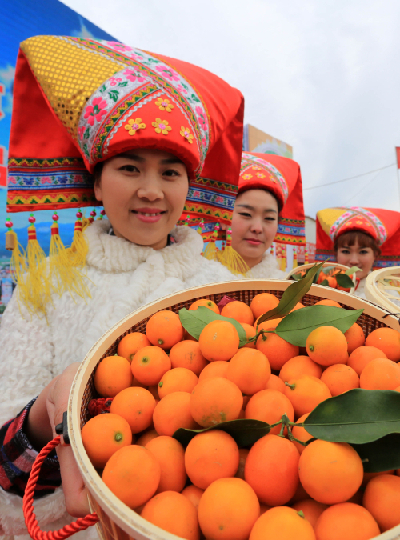|
 |
|
ORANGE-Y GLAD?: Oranges from Rong'an, south China's Guangxi Zhuang Autonomous Region, are presented in a fruit wholesale market in Beijing, on February 7. With a suitable climate, Rong'an produces 87,000 tons of oranges each year (AN KAIXING) |
Liquidity Injection
China's central bank on February 5 lowered the reserve requirement ratio (RRR), the minimum level of reserves banks must hold, by 0.5 percentage points.
This is the first universal RRR cut since May 2012.
The People's Bank of China (PBC) also increased support to some targeted areas, cutting the RRR by extra 0.5 percentage points for qualified city and rural commercial banks engaged in proportionate lending to small firms, the farming sector and major water projects. The Agricultural Development Bank of China, the sole policy lender for agriculture, earned an RRR reduction of 4 percentage points. This is the first time that the central bank has tried a universal RRR cut and a targeted one.
Currently, big banks must hold 20 percent of their deposits in reserve, while the ratio for small and medium-sized banks is 16.5 percent.
The move comes days after the January PMI (purchasing managers' index), a main gauge of manufacturing activity, fell below 50 for the first time since October 2012, a sign of a weakening economy.
The PBC said that it would "continue a prudent monetary policy, striking a balance between tight and loose, guiding monetary credit and private financing to grow steadily and moderately, to promote a healthy and steady economy."
According to estimates by U.S. investment bank J.P. Morgan and some Chinese institutions, the RRR cut could put 650 billion yuan ($104 billion) into the real economy.
Foreign Trade Decline
China's foreign trade tumbled in January as major data experienced a routine decline ahead of the Spring Festival holiday, February 19 to 24 this year.
In January, China's exports dropped 1.4 percent to $200.26 billion, and imports slumped 14.5 percent to $140.23 billion, making the trade surplus expand to $60.03 billion, according to the General Administration of Customs (GAC). Total foreign trade tumbled 7.2 percent year on year to $340.48 billion.
The GAC said the Spring Festival impacts foreign trade data at the beginning of every year. Chinese Lunar New Year, or the Spring Festival, is an important time for family reunions in China.
"The trade data always turn out discouraging at every year's beginning because of the Lunar New Year," Liu Xuezhi, a financial researcher with the Bank of Communications, explained. "The data thereafter can reflect the real situation of China's foreign trade."
He said withering exports, especially labor-intensive industries, reveal the weakening advantage in formerly dominant areas, including machinery, garments, textiles, shoes, toys, furniture and plastics--exports that all saw remarkable drops in January.
He attributed the sharp decrease in imports to lower prices for bulk commodities, ongoing industrial upgrades and reduction of overcapacity.
| 